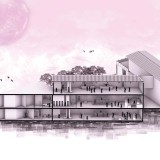Supervisor:
2021
This thesis project is basically a literary expression, a "theatrical work" that comes to complete the work of the previous research project and to continue a cycle that is being created for more than a decade. Six individual acts of a fragmented "body" come to compose the wholeness, through theoretical and design approaches. The almost obsessive disposition to intermingle with Classical Antiquities as well as the unfulfilled desire to understand the ways they are being read, as well as the wider national narrative, has always projected an inner need, as an obligation, to contribute to the decrystallization of certain images. A decrystallization that can only be occured through desecration. The desecration not in the sense of a destruction of the material, but a simpler form of desecration which, according to Agamben, takes place through the contact [contagione] in the sacrifice itself that performs and regulates the transition of the victim from the human to the divine realm. What has been surgically separated and given to the gods can be re-assigned from the ritual to the realm of the profane. The transition from the sanctuared to the desecrated can even take place through a completely inappropriate use [or rather a new use] of the sanctuary.
Within a theoretical framework, in the first act, an attempt to read the history of Metaxourgeio is being made, as it is the district chosen for the birth of this idea, but without overshadowing its contemporary reality. In the second act, the readings of the history of Athens, the national narrative as well as a series of reflections, compose a text that, which as ultimate goal has, an introductory decrystallization of Classical Antiquity, always with respect and recognition of its value. In the third act, and since the design proposal focuses on night entertainment, the contribution of interdisciplinarity was considered necessary for a number of characteristics that it has, from the specific point of view that is being studied, always without missing the literary / emotional character of the general approach. In the fourth act, a record is being made of the formal characteristics and transitions of the field and the building itself, from the moment of its creation. In the fifth act, a detailed reading design of the architecture takes place, and finally in the sixth act, the design proposal is being presented, which comes through the collected knowledge of the previous acts, as parts of a fragmented body, to compose the wholeness.
